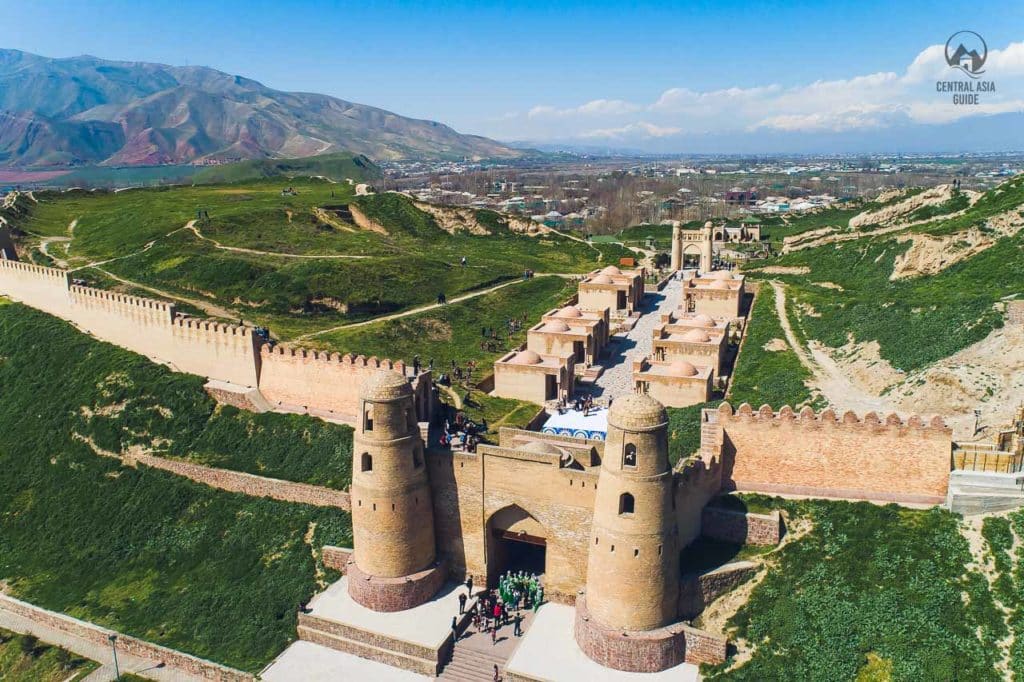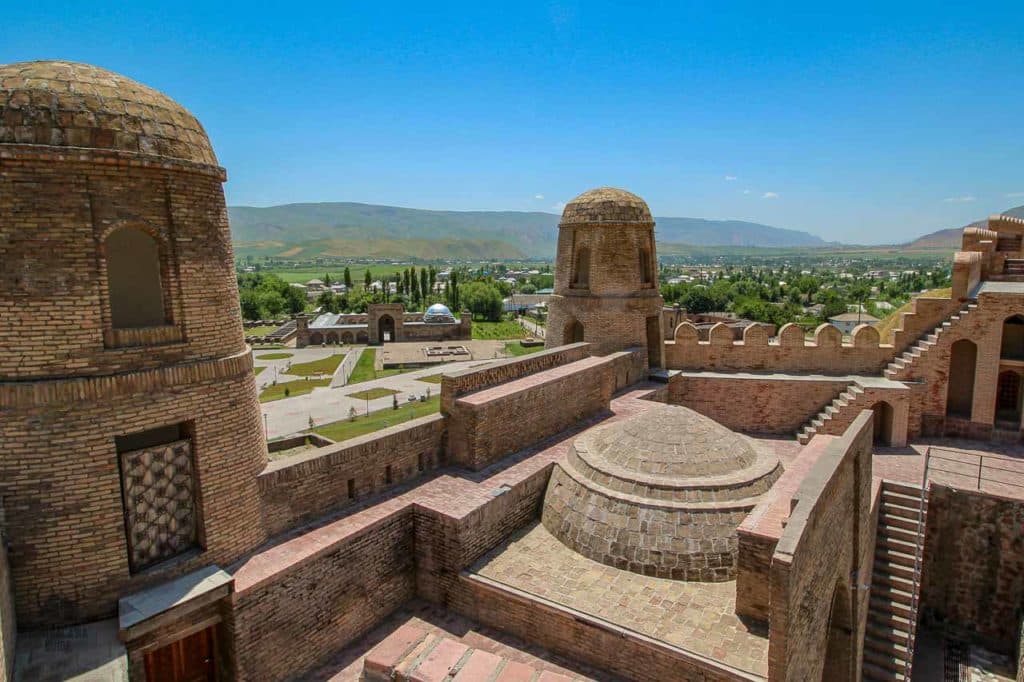Day trip to Hissor from Dushanbe
Hissor Historical & Archaeological day trip
TOUR DETAILS
-
Period
All around the year -
Tour length and Participants
4 - 5 hours; 2 - 4 participants -
Price starting from
33 $ (10 pax group)
HISSOR TOUR HIGHLIGHTS
A day trip from Dushanbe to the historic Hissor Fortress offers a captivating journey through Tajikistan’s rich cultural past. Begin with the majestic Hissor Fortress, an ancient stronghold that once guarded the region and still stands as an impressive symbol of the past. Nearby, explore the Caravanserai, a relic of the Silk Road, where travelers once rested. The two madrasas, one old and one new, showcase traditional Islamic architecture and serve as reminders of the area’s role as an educational hub. End your visit at the Makhdumi Azam Mausoleum, a serene and sacred site honoring a revered Sufi saint.


Tour Itinerary
Due to the commonly hot weather in the Hissar valley, we recommend to start our trip at 8 in the morning in order to arrive back to Dushanbe before the hottest time of the day. The Hissor fortress is located in the Hissor valley, on the west of Dushanbe, close to Hissor city. The distance is about 25 km from Dushanbe and it takes around 45 minutes to drive.
During the day trip to Hissar you will see the following sights:
- Hissor fortress
Some sources say that the Hissor fortress was built 1000 years ago, some others say it was already built in 550BC by Cyrus the Great, during the first Persian Empire - Caravanserai
Opposite the fortress gate, across the square, are the remains of a caravanserai that was built in 1808. A caravanserai is a type of inn, usually used by travelers and their animals. - The old madrasa
Next to the caravanserai is the old madrasa, which was built in the 16th century. A madrasa is a religious school and this one has a large open courtyard with cells along with three of the walls. - The new madrasa
As you come out of the old madrasa, look to your left and you’ll see the new madrasa. It was built between the 17th and 18th centuries but was unfortunately badly damaged,. All that’s left from the original structure, is the two-story facade that you can see. - Makhdumi Azam Mausoleum
The Makhdumi Azam Mausoleum is not obvious and you may not notice it unless you go looking for it. In order to find it, head down the street between the madrasas, away from the fortress and you’ll see it on the left.
Tour Information
Included
- Transportation
- Museum entrance tickets
- Guide service
Not included
- Meals
- Insurance
- Own expenses
Price per group:
| Group | Price |
| 2 pax | $168 |
| 4 pax | $213 |
| 6 pax | $291 |
| 8 pax | $291 |
| 10 pax | $381 |
Book your tour here
If you would like to customize your tour please don’t hesitate to contact us. We are happy to organize a fully customized tour or to provide a modified itinerary based on one of the ready made tours.
Tajikistan travel information

Money & costs

Safety
Entry & exit

Best time to go

Health

Money & costs
Money & costs
Tajikistan operates on the somoni (TJS) as its official currency, although dollars are accepted in some locations. However, the somoni is the primary currency for day-to-day transactions.
Cash withdrawals from ATMs can pose challenges, so it’s recommended to carry some cash to avoid any financial inconveniences. ATMs are accessible in cities such as Dushanbe, Panjakent, Khujand, Khorog, Isfara, Istaravshan, Kurgan-Tube, and even in smaller towns, excluding Murghab.
Eskhata Bank in Dushanbe is considered a reliable option for obtaining US dollars, with a generous withdrawal limit in somoni. However, be aware that ATMs may be less available on weekends. Finding an ATM that accepts Mastercard can be a bit tricky.
Both US dollars and euros are widely acknowledged across Tajikistan. In rural areas lacking formal currency exchange services, people may prefer dollars over euros. It’s essential to note that engaging in currency exchange on the black market is illegal.

Safety
Safety
While the overall security situation is generally stable and Dushanbe is considered relatively safe, occasional incidents of robbery and petty crimes may occur. Individuals with financial resources, including foreigners, could be potential targets. Here are some further recommendations for Tajikistan:
- Always carry a copy of the photo page of your passport, as authorities may request identification.
- Exercise caution by avoiding demonstrations or large gatherings, and maintain vigilance in public spaces.
- For your safety, do not leave your drinks unattended, decline beverages from strangers, and be mindful of your alcohol consumption.
- If you experience being followed or harassed at the airport, promptly report the incident to your tour agent or the consulate office at the airport.
- Show respect for local traditions, customs, laws, and religions at all times.
- Smoking is prohibited while walking on the streets.
- The possession and use of drugs are strictly illegal.
- Women traveling alone in Tajikistan may encounter unwanted attention, harassment, or gender-related difficulties.
- Photographing anything related to the military or security services may lead to complications with local authorities.
- Same-sex sexual relationships are not illegal according to Tajikistan’s legislation. However, conservative local views and levels of tolerance may vary, especially outside major cities.
- Transportation in Tajikistan often involves poorly maintained vehicles, and driving standards are basic. Gas stations outside cities are rare, and emergency services may not be readily available. Ensure you have all necessary supplies for your trip and anticipate potential delays.
- Roads outside major cities are in poor condition and may only be accessible to four-wheel-drive vehicles. Conditions are particularly hazardous in spring due to the risk of avalanches and landslides.
- Tajikistan commonly experiences shortages of energy and water, along with frequent power outages, especially during winter and spring, mostly outside Dushanbe.
- Avoid traveling to the border area with Afghanistan due to the unstable security situation.
- Despite a ceasefire agreement, the security situation remains unstable following military clashes in the Sughd region (Northern Tajikistan), bordering Kyrgyzstan, in September 2022. Khujand is still safe to visit.
- Tajikistan is prone to earthquakes, avalanches, landslides, and floods.
Entry & exit
Entry & exit
Starting from 2022, visitors from 52 countries can enjoy visa-free travel to Tajikistan. For comprehensive visa information, refer to this link. It is crucial to leave Tajikistan before your visa or visa-free entry expires to avoid penalties and the need for an exit visa.
For those planning to explore the Gorno-Badakhshan Autonomous Region (GBAO), obtaining permission is mandatory. Keep in mind that Tajikistan’s borders might close unexpectedly. Declare large amounts of imported funds upon arrival, and when departing, present the customs declaration form.

Best time to go
Best time to go
The ideal time for exploring Tajikistan is during the spring and autumn months, specifically in April, May, June, September, and October. Summers in Tajikistan are characterized by dry and intense heat, with temperatures soaring up to 40°C in the lowlands. Winters can be extremely cold, reaching -20°C in mountainous areas, and heavy snowfall in the western region may disrupt winter routes and close high-altitude mountain passes.
September stands out as perhaps the most favorable time for a journey to Tajikistan, as the heat subsides on the plains, and nearly all but the highest mountain passes remain accessible. Markets come alive with an abundance of delicious fresh produce, and the landscape transforms into a stunning golden autumn. The best time to visit Pamir is in August.

Health
Health
Before embarking on your journey, verify that your chosen destination can offer the required medical assistance you might need. Make sure you possess suitable travel insurance covering both on-site treatment and unexpected medical evacuation. If directed to a medical facility for treatment, promptly contact your insurance provider.
Tajikistan possesses limited medical facilities and faces shortages of essential medications. Medical establishments outside Dushanbe tend to be basic, with some areas having virtually no medical infrastructure.
Certain medications containing codeine are strictly prohibited in Tajikistan. If you intend to bring medications, ensure their legality and acquaint yourself with relevant regulations. Declare all medications and other restricted items upon your arrival.
Ticks are prevalent in forests and rural areas from spring to autumn. The improper disposal of uranium and pesticides in the northern Sughd region poses potential health hazards. It is advisable to get vaccinated at least against Hepatitis A, B and Tetanus at a minimum before your trip.
Other Tours in Tajikistan
Tour updated 20.10.2024